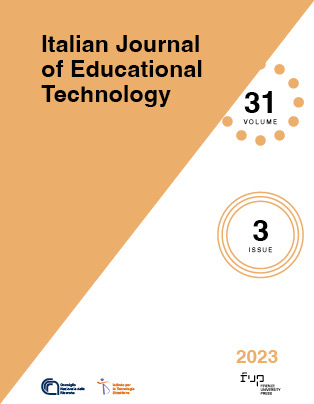L’impatto della valutazione tra pari sulla qualità delle traduzioni in studenti d’inglese come lingua straniera con differenti livelli di rendimento
Contenuto principale dell'articolo
Abstract
L’obiettivo di questo studio è stato quello di esaminare l’impatto della valutazione tra pari sull’apprendimento e sulla motivazione degli studenti a diversi livelli di rendimento (basso, medio e alto). Quarantuno partecipanti, tutti studenti di inglese come lingua straniera (EFL), sono stati invitati a partecipare a questo studio. Tutti hanno completato un progetto di traduzione in inglese, partecipando in seguito a un’attività di valutazione tra pari, leggendo e commentando il lavoro degli altri. Successivamente, gli studenti hanno rivisto e ripresentato i propri progetti di traduzione. L’analisi dei dati suggerisce che l’attività di valutazione tra pari ha migliorato in modo significativo le prestazioni di tutti gli studenti nella traduzione (in termini di aumento dei voti tra la prima e la seconda versione), indipendentemente dai loro livelli di rendimento. Il confronto tra le traduzioni iniziali degli studenti (prima della valutazione tra pari) e quelle finali (dopo la valutazione tra pari) ha rivelato che gli studenti con risultati bassi hanno avuto il maggior grado di miglioramento, seguiti da quelli con risultati medi e poi da quelli con risultati alti. Ciononostante, tutti gli studenti hanno dichiarato di aver apprezzato l’attività di valutazione tra pari e di essersi impegnati in modo analogo, come misurato dalle scale di gradimento e di impegno. L’interpretazione dei risultati e le implicazioni vengono discusse nel contributo.
Dettagli dell'articolo
Gli autori che pubblicano su questa rivista accettano le seguenti condizioni:
- Gli autori mantengono i diritti sulla loro opera e cedono alla rivista il diritto di prima pubblicazione dell'opera, contemporaneamente licenziata sotto una Licenza Creative Commons CC BY 4.0 Attribution 4.0 International License.
- Gli autori possono aderire ad altri accordi di licenza non esclusiva per la distribuzione della versione dell'opera pubblicata (es. depositarla in un archivio istituzionale o pubblicarla in una monografia), a patto di indicare che la prima pubblicazione è avvenuta su questa rivista.
- Gli autori possono diffondere la loro opera online (es. in repository istituzionali o nel loro sito web) prima e durante il processo di submission, poiché può portare a scambi produttivi e aumentare le citazioni dell'opera pubblicata (Vedi The effect of Open Access).
Riferimenti bibliografici
Bertacchini, F., Bilotta, E., Pantano, P., & Tavernise, A. (2012). Motivating the learning of science topics in secondary school: A constructivist edutainment setting for studying chaos. Computers & Education, 59(4), 1377–1386. https://doi.org/10.1016/j.compedu.2012.05.001
Brown, D. (2004). Language assessment: Principles and classroom practice. New York, NY: Longman.
Brutus, S., Donia, M. B., & Ronen, S. (2013). Can business students learn to evaluate better? Evidence from repeated exposure to a peer-evaluation system. Academy of Management Learning & Education, 12(1), 18-31. Retrieved from https://www.jstor.org/stable/23412389
Chien, S. Y., Hwang, G. J., & Jong, M. S. Y. (2020). Effects of peer assessment within the context of spherical video-based virtual reality on EFL students’ English-Speaking performance and learning perceptions. Computers & Education, 146. https://doi.org/10.1016/j.compedu.2019.103751
Colina, S. (2003). Translation teaching, from research to the classroom: A handbook for teachers. New York, NY: McGraw-Hill.
Cheng, W., & Warren, M. (2005). Peer assessment of language proficiency. Language Testing, 22(1), 93-121. https://doi.org/10.1191/0265532205lt29
Cramer, D., & Howitt, D. (2004). The SAGE dictionary of statistics (Vols. 1-0). London, UK: SAGE. doi: 10.4135/9780857020123
Davies, M. G. (2005). Minding the process, improving the product: Alternatives to traditional translator training. In M. Tennent (Ed.). Training for the new millennium: Pedagogies for translation and interpreting (Benjamins Translation Library 60, pp. 67–82). Amsterdam, NL: John Benjamins.
Davies, P. (2000). Computerized peer assessment. Innovations in Education and Training International, 37(4), 346-354. https://doi.org/10.1080/135580000750052955
Deslauriers, L., Schelew, E., & Wieman, C. (2011). Improved learning in a large-enrollment physics class. Science, 332, 862-864. https://doi.org/10.1126/science.1201783
Dochy, F., Segers, M., & Sluijsmans, D. M. A. (1999). The use of self-, peer-, and co-assessment in higher education: A review. Studies in Higher Education, 24(3), 331-350. https://doi.org/10.1080/03075079912331379935
Duncan, D. (2005). Clickers in the classroom: How to enhance science teaching using classroom response systems. San Francisco, CA: Pearson/Addison-Wesley.
Falchikov, N. (2007). The place of peers in learning and assessment. In D. Boud & N. Falchikov (Eds.). Rethinking assessment in higher education: Learning for the longer term (pp. 128-143). New York, NY: Routledge.
Handayani, R. A. D., & Genisa, M. U. (2019). Empowering Physics Students’ Performance in a Group Discussion through two types of peer assessment. International Journal of Instruction, 12(1), 655-668. Retrieved from https://files.eric.ed.gov/fulltext/EJ1201315.pdf
Hersam, M. C., Luna, M., & Light, G. (2004). Implementation of interdisciplinary group learning and peer assessment in a nanotechnology engineering course. Journal of Engineering Education, 93(1), 49-57.
Hiltz, S. R., & Wellman, B. (1997). Asynchronous learning networks as a virtual classroom. Communications of the ACM, 40(2), 44-49.
Hung, Y. J. (2018). Group peer assessment of oral English performance in a Taiwanese elementary school. Studies in Educational Evaluation, 59, 19-28. https://doi.org/10.1016/j.stueduc.2018.02.001
Huynh, T. L., & Nguyen, U. N. T. (2019). Peer assessment in a blended translation course: Students’ perceptions, motivation and their self-perceived translational skill development. International Journal of Applied Linguistics and English Literature, 8(5), 52-60. https://doi.org/10.7575/aiac.ijalel.v.8n.5p.52
Insai, S., & Poonlarp, T. (2017). More heads are better than one: Peer editing in a translation classroom of EFL learners. PASAA: Journal of Language Teaching and Learning in Thailand, 54, 82-107. Retrieved from https://files.eric.ed.gov/fulltext/EJ1171212.pdf
Jin, Y., & Fan, J. (2011). Test for English majors (TEM) in China. Language Testing, 28(4), 589-596. https://doi.org/10.1177/0265532211414
Jonsson, A., & Svingby, G. (2007). The use of scoring rubrics: Reliability, validity and educational consequences. Educational Research Review, 2(2), 130–144. https://doi.org/10.1016/j.edurev.2007.05.002
Kiraly, D. (1995). Pathways to translation: Pedagogy and process. Kent, OH: The Kent State University Press.
Kiraly, D. (2000). A social constructivist approach to translator education: Empowerment from theory to practice. London, UK: Routledge.
Laerd Statistics. (2015). One-way MANOVA in SPSS Statistics. Statistical tutorials and software guides. Retrieved from https://statistics.laerd.com/spss-tutorials/one-way-manova-using-spss-statistics.php
Li, H., Xiong, Y., Hunter, C. V., Guo, X., & Tywoniw, R. (2020). Does peer assessment promote student learning? A meta-analysis. Assessment & Evaluation in Higher Education, 45(2), 193-211. https://doi.org/10.1080/02602938.2019.1620679
Li, L. (2011). How do students of diverse achievement levels benefit from peer assessment? International Journal for Scholarship of Teaching and Learning, 5(2). https://doi.org/10.20429/ijsotl.2011.050214
Li, L., & Gao, F. (2016). The effect of peer assessment on project performance of students at different learning levels. Assessment & Evaluation in Higher Education, 41(6), 885-900. https://doi.org/10.1080/02602938.2015.1048185
Li, L., & Grion, V. (2019). The power of giving feedback and receiving feedback in peer assessment. All Ireland Journal of Higher Education, 11(2). Retrieved from https://ojs.aishe.org/index.php/aishe-j/article/view/413
Li, L., & Steckelberg, A. L. (2005). Impact of technology-mediated peer assessment on student project quality. In Simonson, M. & Crawford, M. (Eds.), Proceedings of the Association for Educational Communications and Technology International Conference 2005 (pp. 307-313). Orlando, FL.
Li, L., Steckelberg, A. L., & Srinivasan, S. (2008). Utilizing peer interactions to promote learning through a web-based peer assessment system. Canadian Journal of Learning and Technology, 34(2), 133-148. https://doi.org/10.21432/T21C7R
Li, H., Xiong, Y., Hunter, C. V., Guo, X., & Tywoniw, R. (2020). Does peer assessment promote student learning? A meta-analysis. Assessment & Evaluation in Higher Education, 45(2), 193-211. https://doi.org/10.1080/02602938.2019.1620679
Lin, Z., Song, X., Guo, J., & Wang, F. (2021). Peer feedback in translation training: A quasi-experiment in an advanced Chinese–English translation course. Frontiers in Psychology, 12. https://doi.org/10.3389/fpsyg.2021.631898
Liu, C., Wan, P., Tu, Y. F., Chen, K., & Wang, Y. (2021). A WSQ-based mobile peer assessment approach to enhancing university students’ vocal music skills and learning perceptions. Australasian Journal of Educational Technology, 37(6), 1-17. https://doi.org/10.14742/ajet.6832
Lucas, A. (2009). Using peer instruction and i-clickers to enhance student participation in calculus. Primus, 19(3), 219–231. https://doi.org/10.1080/10511970701643970
Lynch, R., McNamara, P. M., & Seery, N. (2012). Promoting deep learning in a teacher education programme through self-and peer-assessment and feedback. European Journal of Teacher Education, 35(2), 179-197. https://doi.org/10.1080/02619768.2011.643396
McAuley, E., Duncan, T., & Tammen, V. V. (1989). Psychometric properties of the Intrinsic Motivation Inventory in a competitive sport setting: a confirmatory factor analysis. Research Quarterly for Exercise and Sport, 60(1), 48-58. https://doi.org/10.1080/02701367.1989.10607413
Orsmond, P., Merry, S. & Reiling, K. (1996). The importance of marking criteria in the use of peer assessment. Assessment & Evaluation in Higher Education, 21(3), 239-250.
Patri, M. (2002). The influence of peer feedback on self- and peer-assessment of oral skills. Language Testing, 19(2), 109-131.
Pope, N. (2001). An examination of the use of peer rating for formative assessment in the context of the theory of consumption values. Assessment & Evaluation in Higher Education, 26(3), 235-246.
Robinson, J. (1999). Computer-assisted peer review. In S. Brown, J. Bull, & P. Race (Eds.), Computer-assisted assessment in higher education (pp. 95-102). London, UK: Kogan Page
Rollinson, P. (2005). Using peer feedback in the ESL writing class. ELT Journal, 59(1), 23-30.
Ryan, R. M. (1982). Control and information in the intrapersonal sphere: An extension of cognitive evaluation theory. Journal of Personality and Social Psychology, 43, 450-461.
Salkind, N. J. (2010). Encyclopedia of research design (Vols. 1-3). Thousand Oaks, CA: SAGE. https://doi.org/10.4135/9781412961288
Shen, B., Bai, B., & Xue, W. (2020). The effects of peer assessment on learner autonomy: An empirical study in a Chinese college English writing class. Studies in Educational Evaluation, 64. https://doi.org/10.1016/j.stueduc.2019.100821
Somervell, H. (1993). Issues in assessment, enterprise and higher education: The case for self-, peer and collaborative assessment. Assessment & Evaluation in Higher Education, 18(3), 221–233.
Stemler, S. E. (2004). A comparison of consensus, consistency, and measurement approaches to estimating interrater reliability. Practical Assessment, Research, and Evaluation, 9(4), 1–11.
TEM Test Center (1997). The Test for English Majors (TEM) validation study. Shanghai, CN: Shanghai Foreign Language Education Press.
Tiew, F. (2010). Business students’ views of peer assessment on class participation. International Education Studies, 3(3), 126-131.
van Zundert, M., Sluijsmans, D., & Van Merriënboer, J. (2010). Effective peer assessment processes: Research findings and future directions. Learning and Instruction, 20(4), 270-279.
Violato, C., & Lockyer, J. (2006). Self and peer assessment of pediatricians, psychiatrists and medicine specialists: Implications for self-directed learning. Advances in Health Sciences Education, 11(3), 235-244.
Wang, K., & Han, C. (2013). Accomplishment in the multitude of counsellors: Peer feedback in translation training. Translation & Interpreting, 5(2), 62-75. https://doi.org/doi: 10.12807/ti.105202.2013.a05
Wang, Y., Li, H., Feng, Y., Jiang, Y., & Liu, Y. (2012). Assessment of programming language learning based on peer code review model: Implementation and experience report. Computers & Education, 59(2), 412-422. https://doi.org/10.1016/j.compedu.2012.01.007
Zhan, Y. (2021). What matters in design? Cultivating undergraduates’ critical thinking through online peer assessment in a Confucian heritage context. Assessment & Evaluation in Higher Education, 46(4), 615-630. https://doi.org/10.1080/02602938.2020.1804826
Zhang, Y., Lin, M., Nonaka, A., & Beom, K. (2005). Harmony, hierarchy and conservatism: A cross-cultural comparison of Confucian values in China, Korea, Japan, and Taiwan. Communication Research Reports, 22(2), 107-115. https://doi.org/10.1080/00036810500130539
Zou, D., Xie, H., & Wang, F. L. (2021). Peer-assessment enhanced collaborative learning in a virtual learning environment. International Conference on Blended Learning (pp. 132-141). Cham, CH: Springer. https://doi.org/10.1007/978-3-030-80504-3_11

